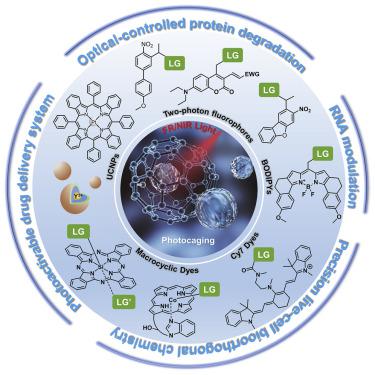Chem ( IF 19.1 ) Pub Date : 2022-12-01 , DOI: 10.1016/j.chempr.2022.11.007 Hao Xiong , Yunjie Xu , Byungkook Kim , Hyeonji Rha , Bin Zhang , Mingle Li , Guang-Fu Yang , Jong Seung Kim

|
Photochemical tools have revolutionized the landscape of biomedicine, enabling the exploration of nature in a noninvasively remote-controlled manner. Among them, especially appealing is the photocage. Recently, significant breakthroughs in photocages have been achieved in drug delivery systems, optical-controlled protein degradation, and RNA modulation. However, existing photocages have mostly centered on excitation in the ultraviolet-visible range, which has limited penetration depth, thus hindering their practical applications. In contrast, deep red or NIR light within the “phototherapeutic window” (650–900 nm) has unique advantages, such as minimized side effects and superior deep-tissue penetration. Nevertheless, strategies to rationally design such photocages and their underlying photochemical mechanisms of action remain elusive. Here, we plan to provide a comprehensive overview of recent advances of photocages in the phototherapeutic window, including their design principles, photocaging performance, photoactivation mechanism, and emerging utilizations in biomedical chemistry. It is hoped that this review will inspire the future development of photocage-related research.
中文翻译:

光控生物化学:利用光疗窗口中的光笼
光化学工具彻底改变了生物医学领域,使人们能够以非侵入式远程控制方式探索自然。其中,特别吸引人的是photocage。最近,photocages 在药物输送系统、光控蛋白质降解和 RNA 调制方面取得了重大突破。然而,现有的光笼大多集中在紫外-可见光范围内的激发,穿透深度有限,从而阻碍了它们的实际应用。相比之下,“光疗窗口”(650-900 nm)内的深红色或近红外光具有独特的优势,例如最小化副作用和卓越的深层组织穿透力。然而,合理设计此类光笼及其潜在光化学作用机制的策略仍然难以捉摸。这里,我们计划全面概述光笼在光疗窗口中的最新进展,包括它们的设计原理、光笼性能、光激活机制以及在生物医学化学中的新兴应用。希望这篇综述能对光笼相关研究的未来发展有所启发。











































 京公网安备 11010802027423号
京公网安备 11010802027423号